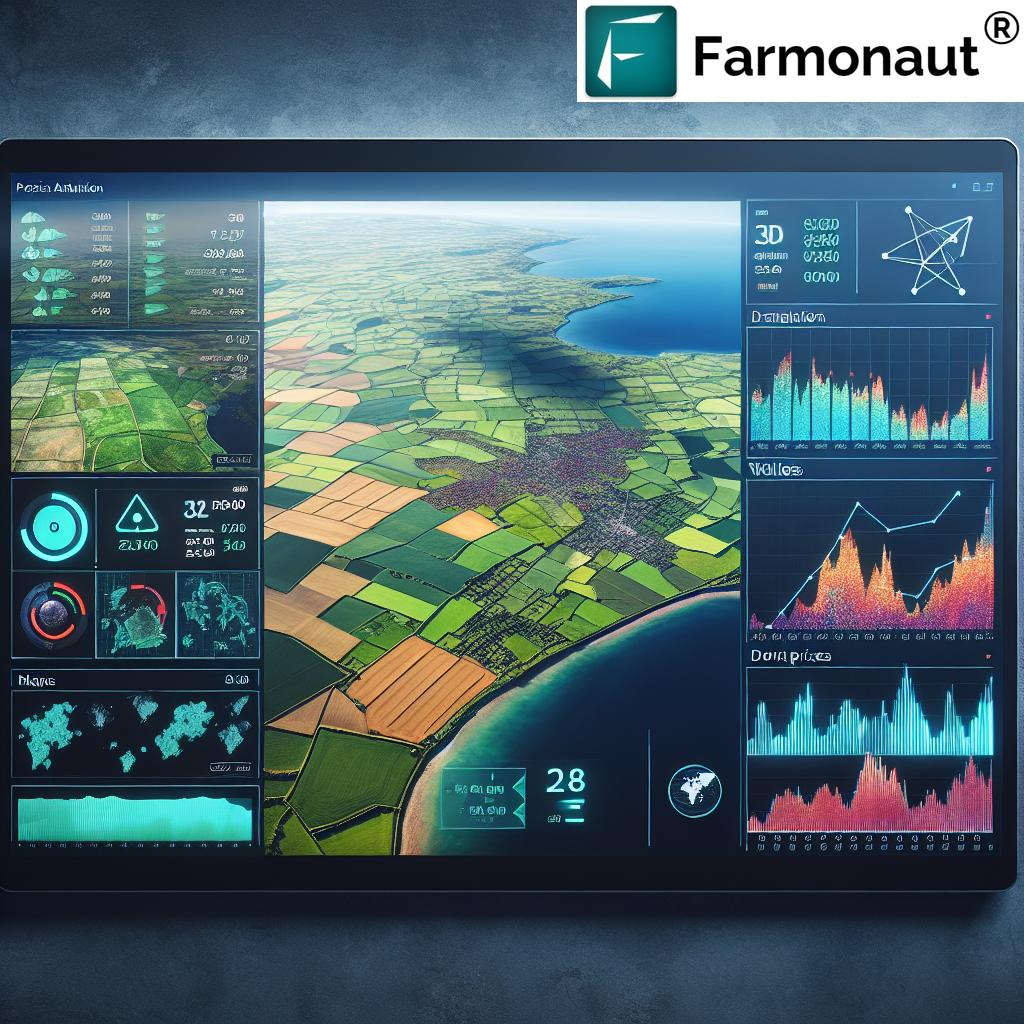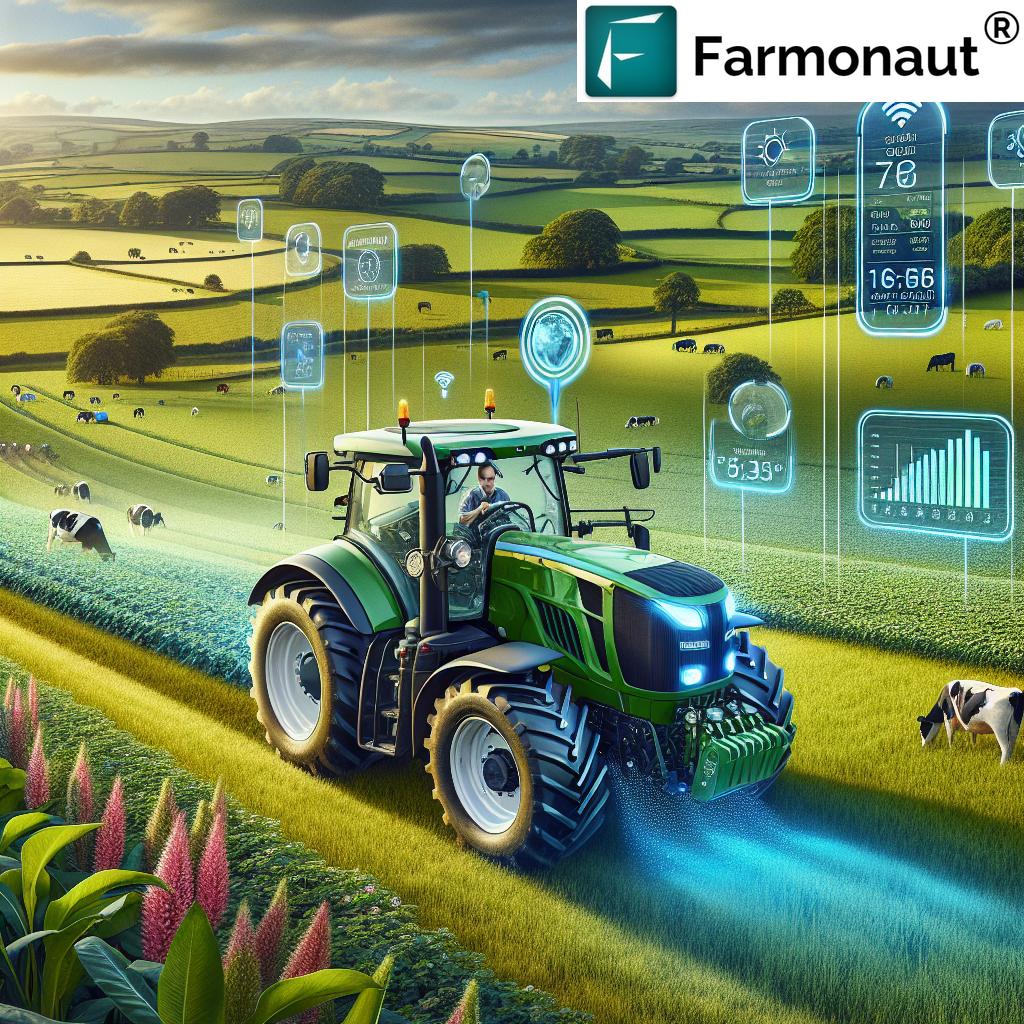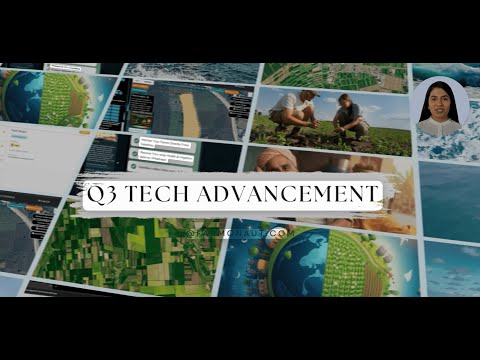UK Food Supply Chain Crisis: How Digital Farming Solutions Can Boost Agricultural Resilience
“UK farmers face a triple threat: 40% rise in fertilizer costs, 30% increase in fuel prices, and 20% surge in animal feed expenses.”
In recent years, the United Kingdom’s agricultural sector has been grappling with unprecedented challenges that threaten the very foundation of our food supply chains. From the rolling hills of England to the rugged landscapes of Scotland and the verdant valleys of Wales, farmers across the nation are facing a perfect storm of difficulties. In this comprehensive exploration, we at Farmonaut will delve into the critical issues affecting UK food supply chain challenges and examine how digital farming solutions can strengthen agricultural supply chain resilience.

The Current State of UK Agriculture
The agricultural landscape in the UK is experiencing seismic shifts that are sending shockwaves through our domestic food production strategies. Let’s break down the key factors contributing to this crisis:
- Supply Chain Disruptions: Brexit-related changes and global events have strained our imports, leading to shortages and increased costs for essential farm inputs.
- Regulatory Changes: New agricultural policies post-Brexit have introduced uncertainties for farmers across England, Scotland, and Wales.
- Rising Production Costs: Skyrocketing prices for fuel, fertilizers, and animal feed are squeezing profit margins for farmers.
- Labour Shortages: Reduced access to seasonal workers has left many farms struggling to harvest crops and manage livestock.
- Climate Variability: Extreme weather events are becoming more frequent, posing risks to crop yields and livestock health.
These challenges are not just statistics; they represent real threats to the livelihoods of our farmers and the food security of our nation. As we face this crisis, it’s clear that innovative solutions are needed to bolster the resilience of our agricultural sector.
The Role of Digital Farming in Addressing UK Agricultural Challenges
In the face of these formidable challenges, digital farming trends and agricultural technology solutions are emerging as powerful tools to help farmers adapt and thrive. Let’s explore how these innovations can address specific issues:
Precision Agriculture Tools
Precision agriculture is revolutionizing farming practices across the UK. By leveraging data-driven insights, farmers can optimize their operations for maximum efficiency and sustainability. Here’s how precision agriculture tools are making a difference:
- Satellite-Based Crop Monitoring: Advanced platforms like Farmonaut use satellite imagery to provide real-time data on crop health, allowing farmers to detect issues early and take targeted action.
- Smart Irrigation Systems: These systems use soil moisture sensors and weather data to optimize water usage, crucial for regions facing water scarcity.
- Variable Rate Technology (VRT): VRT enables farmers to apply inputs like fertilizers and pesticides with pinpoint accuracy, reducing waste and environmental impact.
By implementing these precision agriculture tools, UK farmers can significantly improve their resource management and crop yields, helping to offset rising production costs and mitigate the effects of climate variability.
Crop Management Systems
Digital crop management systems are transforming how farmers plan, monitor, and optimize their agricultural operations. These systems offer a range of benefits:
- Data-Driven Decision Making: By collecting and analyzing data on factors like soil health, weather patterns, and crop performance, farmers can make more informed decisions about planting, fertilizing, and harvesting.
- Predictive Analytics: Advanced algorithms can forecast potential issues such as pest infestations or disease outbreaks, allowing for proactive management.
- Resource Optimization: These systems help farmers allocate resources more efficiently, reducing waste and improving profitability.
Farmonaut’s crop management system, for instance, integrates satellite imagery with AI-driven analytics to provide farmers with actionable insights for improving their operations. This technology is particularly valuable for arable farmers looking to maximize yields while minimizing input costs.
“Precision agriculture tools can reduce water usage by up to 30% and increase crop yields by 15% in UK farming operations.”
Digital Supply Chain Management
To address the challenges in our food supply chains, digital solutions are proving invaluable. Here’s how they’re making an impact:
- Blockchain-Based Traceability: This technology ensures transparency and security throughout the supply chain, from farm to consumer. It’s particularly useful for verifying the origin and quality of produce, which is crucial for maintaining consumer trust and meeting regulatory requirements.
- Real-Time Inventory Management: Digital systems allow for better tracking of agricultural products, reducing waste and improving efficiency in distribution.
- Data-Driven Market Analysis: By analyzing market trends and consumer preferences, these systems help farmers and distributors make better decisions about what to produce and when to bring products to market.
These digital supply chain management tools are essential for improving the resilience and efficiency of UK food supply chains, helping to mitigate the impact of disruptions and regulatory changes.
Farm Diversification Techniques in the Digital Age
As UK farmers face mounting pressures, farm diversification has become a crucial strategy for maintaining profitability and resilience. Digital technologies are opening up new avenues for diversification:
- Direct-to-Consumer Platforms: Online marketplaces and e-commerce solutions allow farmers to sell directly to consumers, bypassing traditional supply chains and potentially increasing profits.
- Agritourism Opportunities: Digital marketing tools and booking platforms can help farmers promote and manage agritourism ventures, such as farm stays or educational tours.
- Value-Added Products: Data analytics can help farmers identify opportunities for creating value-added products, such as artisanal cheeses or specialty crops, based on market demand.
By embracing these digital farm diversification techniques, UK farmers can create additional revenue streams and reduce their reliance on traditional farming models.
Sustainable Farming Practices Enhanced by Digital Solutions
Sustainability is no longer just a buzzword; it’s a necessity for the future of UK agriculture. Digital farming solutions are playing a crucial role in promoting and implementing sustainable farming practices:
- Precision Livestock Farming: Digital tools for monitoring animal health and behavior can improve welfare standards and reduce the need for antibiotics in livestock and dairy farming.
- Carbon Footprint Tracking: Advanced software can help farmers measure and reduce their carbon emissions, aligning with national sustainability goals and potentially opening up new revenue streams through carbon credits.
- Integrated Pest Management (IPM): Digital systems can support IPM strategies by providing early warning of pest and disease risks, reducing the reliance on chemical pesticides.
By adopting these digitally-enhanced sustainable farming practices, UK farmers can not only reduce their environmental impact but also improve their long-term viability and meet growing consumer demand for sustainably produced food.
The Impact of Digital Solutions on Different Farming Sectors
Digital farming solutions are not one-size-fits-all; they offer tailored benefits to various sectors of UK agriculture. Let’s explore how these technologies are impacting different types of farming:
Arable Farming
For arable farmers, digital solutions are revolutionizing crop management:
- Satellite-Based Crop Monitoring: Platforms like Farmonaut provide real-time insights into crop health, allowing for timely interventions.
- Precision Planting: GPS-guided machinery ensures optimal seed placement and spacing, improving yields and reducing waste.
- Automated Spraying Systems: These reduce chemical usage by targeting only affected areas, saving costs and minimizing environmental impact.
Livestock and Dairy Farming
Digital technologies are transforming animal husbandry practices:
- Wearable Devices for Cattle: These monitor health metrics and behavior, enabling early detection of issues like lameness or illness.
- Automated Feeding Systems: These ensure optimal nutrition for livestock, improving health and productivity.
- Digital Herd Management: Software solutions help track breeding cycles, milk production, and individual animal performance.
Grassland Management
For farms with extensive grazing lands, digital tools offer new possibilities:
- Pasture Monitoring Systems: These use satellite imagery and ground sensors to assess grass quality and quantity, optimizing grazing patterns.
- Virtual Fencing: GPS-enabled collars can create movable boundaries for livestock, improving land use efficiency.
- Soil Health Analysis: Digital soil testing kits provide quick, accurate data on soil nutrients, helping farmers make informed decisions about fertilization and crop rotation.

The Role of Government Support in Digital Agriculture Adoption
While digital farming solutions offer immense potential, their widespread adoption requires supportive government policies and initiatives. Here’s how policymakers can help:
- Funding for Digital Infrastructure: Investing in rural broadband and 5G networks to ensure farmers can access digital technologies.
- Grants and Subsidies: Providing financial support for farmers to invest in digital farming equipment and software.
- Education and Training Programs: Offering resources to help farmers and agricultural workers develop digital skills.
- Regulatory Framework: Developing clear guidelines for data privacy and security in agricultural technology.
By implementing these measures, the UK government can create an environment that encourages innovation and supports the transition to more resilient and sustainable farming practices.
Overcoming Barriers to Digital Adoption in UK Farming
Despite the clear benefits of digital farming solutions, there are several barriers to adoption that need to be addressed:
- Initial Costs: Many farmers are hesitant to invest in new technologies due to the upfront expenses. Solutions like Farmonaut’s subscription-based model can help mitigate this issue by offering affordable entry points.
- Digital Literacy: Some farmers may lack the technical skills to implement and use digital tools effectively. Industry-led training programs and user-friendly interfaces are crucial for overcoming this challenge.
- Data Privacy Concerns: Farmers need assurances that their data will be protected and used ethically. Clear data governance frameworks and transparent policies are essential.
- Compatibility Issues: Ensuring that different digital systems can work together seamlessly is crucial for maximizing their benefits.
Addressing these barriers will be crucial for accelerating the adoption of digital farming solutions across the UK.
The Future of UK Agriculture: Embracing Digital Innovation
As we look to the future, it’s clear that digital innovation will play a central role in shaping UK agriculture. Here are some emerging trends and technologies to watch:
- Artificial Intelligence and Machine Learning: These technologies will enable even more sophisticated predictive analytics and decision-support systems for farmers.
- Internet of Things (IoT) in Agriculture: The proliferation of connected devices will create a more comprehensive and real-time picture of farm operations.
- Robotics and Automation: As labor shortages persist, we can expect to see increased adoption of robotic systems for tasks like harvesting and weeding.
- Vertical Farming and Controlled Environment Agriculture: These technologies could revolutionize urban food production and increase resilience to climate variability.
By staying at the forefront of these innovations, UK agriculture can not only overcome current challenges but also position itself as a global leader in sustainable and efficient food production.
UK Agricultural Challenges and Digital Solutions Comparison
| Challenge | Impact on UK Farming | Digital Solution |
|---|---|---|
| Supply Chain Disruptions | Shortages of inputs, increased costs | Blockchain-based traceability, real-time inventory management |
| Regulatory Changes | Uncertainty in agricultural policies | Digital compliance tools, AI-powered policy interpretation |
| Rising Production Costs | Reduced profit margins for farmers | Precision agriculture for resource optimization, smart machinery |
| Climate Variability | Unpredictable yields, crop damage | Satellite-based crop monitoring, AI weather prediction |
| Labor Shortages | Difficulties in harvesting and farm management | Robotic farming systems, IoT-enabled farm management |
Conclusion: A Digital Path to Resilient UK Agriculture
The UK food supply chain crisis presents significant challenges, but it also offers an opportunity for transformation. By embracing digital farming solutions, we can build a more resilient, sustainable, and productive agricultural sector. From precision agriculture tools to blockchain-based traceability, these technologies have the power to address the core issues facing UK farmers today.
As we’ve explored, platforms like Farmonaut are at the forefront of this digital revolution, offering accessible and powerful tools for farmers across the UK. By combining satellite technology, AI, and user-friendly interfaces, such solutions are democratizing access to precision agriculture and helping farmers make data-driven decisions.
The path forward requires collaboration between farmers, technology providers, policymakers, and consumers. By working together and leveraging the power of digital innovation, we can ensure the long-term viability of UK agriculture, strengthen our food security, and support the livelihoods of farmers across England, Scotland, and Wales.
The future of UK farming is digital, and the time to embrace this future is now. Let’s cultivate resilience through innovation and work towards a sustainable and prosperous agricultural sector for generations to come.
FAQ Section
- Q: How can digital farming solutions help small-scale farmers in the UK?
A: Digital farming solutions can level the playing field for small-scale farmers by providing affordable access to precision agriculture tools, market insights, and efficient resource management techniques. Platforms like Farmonaut offer scalable solutions that can be tailored to farms of all sizes. - Q: What are the main benefits of adopting digital farming practices?
A: The main benefits include increased productivity, reduced input costs, improved sustainability, better decision-making through data analytics, and enhanced traceability for food safety and consumer trust. - Q: How does satellite-based crop monitoring work?
A: Satellite-based crop monitoring uses multispectral imagery to assess crop health, soil moisture, and other vital metrics. This data is analyzed using AI algorithms to provide farmers with actionable insights for crop management. - Q: Are digital farming solutions cost-effective for UK farmers?
A: While there may be initial investment costs, many digital farming solutions offer significant return on investment through improved yields, reduced waste, and optimized resource use. Subscription-based models like Farmonaut’s can make these technologies more accessible. - Q: How can digital solutions address labor shortages in UK agriculture?
A: Digital solutions can help address labor shortages through automation of routine tasks, improved efficiency in operations, and better workforce management tools. This allows farmers to optimize their existing workforce and reduce reliance on seasonal labor.
For more information on how Farmonaut can help you embrace digital farming solutions, visit our web app or check out our mobile apps:
For developers interested in integrating our technology into their own solutions, explore our API and API Developer Docs.





